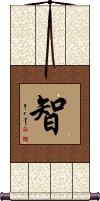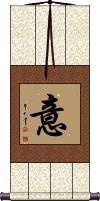Many custom options...
And formats...

Not what you want?
Try other similar-meaning words, fewer words, or just one word.
Intelligence Intellect in Chinese / Japanese...
Buy an Intelligence Intellect calligraphy wall scroll here!
Personalize your custom “Intelligence Intellect” project by clicking the button next to your favorite “Intelligence Intellect” title below...
Intelligence / Intellect
These two characters mean intelligence or intelligent.
The first character means wisdom, intellect, or knowledge.
The second means ability, talent, skill, capacity, capable, able, and can even mean competent.
Together, 知能 can mean “capacity for wisdom,” “useful knowledge,” or even “mental power.” Obviously, this translates more clearly into English as “intelligence.”
Note: This is not the same word used to mean “military intelligence.” See our other entry for that.
![]() In modern Japan, they tend to use a version of the first character without the bottom radical. If your audience for this artwork is Japanese, please click on the Kanji to the right instead of the button above.
In modern Japan, they tend to use a version of the first character without the bottom radical. If your audience for this artwork is Japanese, please click on the Kanji to the right instead of the button above.
Wisdom
智 is the simplest way to write wisdom in Chinese, Korean Hanja, and Japanese Kanji.
Being a single character, the wisdom meaning is open to interpretation, and can also mean intellect, knowledge or reason, resourcefulness, or wit.
智 is also one of the five tenets of Confucius.
智 is sometimes included in the Bushido code but is usually not considered part of the seven key concepts of the code.
See our Wisdom in Chinese, Japanese and Korean page for more wisdom-related calligraphy.
See Also: Learn From Wisdom | Confucius
Idea / Thought / Meaning
意 is the Chinese, Japanese Kanji, and old Korean Hanja for an idea, intention, meaning, thought, wish, desire, intention, feelings, and thoughts.
In Buddhism, this is the last of the six means of perception (the others are sight, hearing, smell, taste, and touch, and this one represents the mind). It does not literally mean “mind,” but rather something more like mental powers, intellect, intelligence, faculty of thought, or understanding in the Buddhist context.
Not the results for Intelligence Intellect that you were looking for?
Below are some entries from our dictionary that may match your Intelligence Intellect search...
| Characters If shown, 2nd row is Simp. Chinese |
Pronunciation Romanization |
Simple Dictionary Definition |
意 see styles |
yì yi4 i i い |
More info & calligraphy: Idea / Thought / Meaning(1) feelings; thoughts; (2) meaning; (personal name) Kokoro Manas, the sixth of the ṣaḍāyatanas or six means of perception, i.e. sight, hearing, smell, taste, touch, and mind. Manas means "mind (in its widest sense as applied to all the mental powers), intellect, intelligence, understanding, perception, sense, conscience, will". M.W. It is "the intellectual function of consciousness", Keith. In Chinese it connotes thought, idea, intention, meaning, will; but in Buddhist terminology its distinctive meaning is mind, or the faculty of thought. |
智能 see styles |
zhì néng zhi4 neng2 chih neng chinou / chino ちのう |
More info & calligraphy: Intelligence / Intellectintelligence; intellect; brains |
叡智 see styles |
ruì zhì rui4 zhi4 jui chih eichi / echi えいち |
wisdom; intelligence; intellect; (female given name) Eichi wise |
叡知 see styles |
eichi / echi えいち |
wisdom; intelligence; intellect; (personal name) Eichi |
智力 see styles |
zhì lì zhi4 li4 chih li chiriki ちりき |
intelligence; intellect (noun - becomes adjective with の) wisdom; intellectual power; intelligence; mental capacity; brains; (given name) Chiriki Knowledge and supernatural power; power of knowledge; the efficient use of mystic knowledge. |
理智 see styles |
lǐ zhì li3 zhi4 li chih richi りち |
reason; intellect; rationality; rational intellect; intelligence; (female given name) Richi Principle and gnosis (or reason); the noumenal in essence and in knowledge; the truth in itself and in knowledge; li is also the fundamental principle of the phenomenon under observation, chih the observing wisdom; one is reality, the other the knower or knowing; one is the known object, the other the knower, the knowing, or what is known; each is dependent on the other, chih depends on lili is revealed by chih. Also knowledge or enlightenment in its essence or purity, free from incarnational influences. |
理知 see styles |
richi りち |
intellect; intelligence; (female given name) Richi |
睿智 see styles |
ruì zhì rui4 zhi4 jui chih eichi / echi えいち |
wise and farsighted wisdom; intelligence; intellect |
知能 see styles |
chino ちの |
intelligence; intellect; brains; (surname) Chino |
英智 see styles |
hidenori ひでのり |
wisdom; intelligence; intellect; (personal name) Hidenori |
英知 see styles |
hidetomo ひでとも |
wisdom; intelligence; intellect; (given name) Hidetomo |
胎藏界 see styles |
tāi zàng jiè tai1 zang4 jie4 t`ai tsang chieh tai tsang chieh taizō kai |
Garbhadhātu, or Garbhakośa-(dhātu), the womb treasury, the universal source from which all things are produced; the matrix; the embryo; likened to a womb in which all of a child is conceived— its body, mind, etc. It is container and content; it covers and nourishes; and is the source of all supply. It represents the 理性 fundamental nature, both material elements and pure bodhi, or wisdom in essence or purity; 理 being the garbhadhātu as fundamental wisdom, and 智 acquired wisdom or knowledge, the vajradhātu. It also represents the human heart in its innocence or pristine purity, which is considered as the source of all Buddha-pity and moral knowledge. And it indicates that from the central being in the maṇḍala, viz. the Sun as symbol of Vairocana, there issue all the other manifestations of wisdom and power, Buddhas, bodhisattvas, demons, etc. It is 本覺 original intellect, or the static intellectuality, in contrast with 始覺 intellection, the initial or dynamic intellectuality represented in the vajradhātu; hence it is the 因 cause and vajradhātu the 果 effect; though as both are a unity, the reverse may be the rule, the effect being also the cause; it is also likened to 利他 enriching others, as vajradhātu is to 自利 enriching self. Kōbō Daishi, founder of the Yoga or Shingon 眞言 School in Japan, adopted the representation of the ideas in maṇḍalas, or diagrams, as the best way of revealing the mystic doctrine to the ignorant. The garbhadhātu is the womb or treasury of all things, the universe; the 理 fundamental principle, the source; its symbols are a triangle on its base, and an open lotus as representing the sun and Vairocana. In Japan this maṇḍala is placed on the east, typifying the rising sun as source, or 理. The vajradhātu is placed west and represents 智 wisdom or knowledge as derived from 理 the underlying principle, but the two are essential one to the other, neither existing apart. The material and spiritual; wisdom-source and intelligence; essence and substance; and similar complementary ideas are thus portrayed; the garbhadhātu may be generally considered as the static and the vajradhātu as the dynamic categories, which are nevertheless a unity. The garbhadhātu is divided into 三部 three sections representing samādhi or quiescence, wisdom-store, and pity-store, or thought, knowledge, pity; one is called the Buddha-section, the others the Vajra and Lotus sections respectively; the three also typify vimokṣa, prajñā, and dharmakāya, or freedom, understanding, and spirituality. There are three heads of these sections, i. e. Vairocana, Vajrapāṇi, and Avalokiteśvara; each has a mother or source, e. g. Vairocana from Buddha's-eye; and each has a 明王 or emanation of protection against evil; also a śakti or female energy; a germ-letter, etc. The diagram of five Buddhas contains also four bodhisattvas, making nine in all, and there are altogether thirteen 大院 or great courts of various types of ideas, of varying numbers, generally spoken of as 414. Cf. 金剛界; 大日; 兩部. |
阿賴耶識 阿赖耶识 see styles |
ā lài yé shì a1 lai4 ye2 shi4 a lai yeh shih araya shiki |
ālaya-vijñāna. 'The receptacle intellect or consciousness;' 'the orginating or receptacle intelligence;' 'basic consciousness' (Keith). It is the store or totality of consciousness, both absolute and relative, impersonal in the whole, temporally personal or individual in its separated parts, always reproductive. It is described as 有情根本之心識 the fundamental mind-consciousness of conscious beings, which lays hold of all the experiences of the individual life: and which as storehouse holds the germs 種子 of all affairs; it is at the root of all experience, of the skandhas, and of all things on which sentient beings depend for existence. Mind is another term for it, as it both stores and gives rise to all seeds of phenomena and knowledge. It is called 本識 original mind, because it is the root of all things; 無沒識 inexhaustible mind, because none of its seeds (or products) is lost; 現識 manifested mind, because all things are revealed in or by it; 種子識 seeds mind, because from it spring all individualities, or particulars; 所知依識 because it is the basis of all knowledge; 異熟識 because it produces the rounds of morality, good and evil karma, etc.; 執持識 or 阿陀那 q.v., that which holds together, or is the seed of another rebirh, or phenomena, the causal nexus; 第一識 the prime or supreme mind or consciousness; 宅識 abode (of) consciousness; 無垢識 unsullied consciousness when considered in the absolute, i.e. the Tathāgata; and 第八識, as the last of the eight vijñānas. There has been much discussion as to the meaning and implications of the ālaya-vijñāna. It may also be termed the unconscious, or unconscious absolute, out of whose ignorance or unconsciousness rises all consciousness. |
Variations: |
richi りち |
intellect; intelligence |
Variations: |
chiryoku ちりょく |
intellectual power; mental capacity; intellect; intelligence; brains |
Variations: |
chinou / chino ちのう |
intelligence; intellect; brains |
Variations: |
chinou / chino ちのう |
intelligence; intellect; brains |
Variations: |
eichi / echi えいち |
wisdom; intelligence; intellect |
The following table may be helpful for those studying Chinese or Japanese...
| Title | Characters | Romaji (Romanized Japanese) | Various forms of Romanized Chinese | |
| Intelligence Intellect | 智能 / 知能 智能 | chinou / chino | zhì néng / zhi4 neng2 / zhi neng / zhineng | chih neng / chihneng |
| Wisdom | 智 | chi / tomo | zhì / zhi4 / zhi | chih |
| Idea Thought Meaning | 意 | kokoro | yì / yi4 / yi | i |
| In some entries above you will see that characters have different versions above and below a line. In these cases, the characters above the line are Traditional Chinese, while the ones below are Simplified Chinese. | ||||
Successful Chinese Character and Japanese Kanji calligraphy searches within the last few hours...






